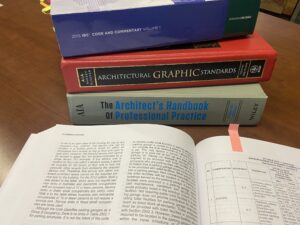Some Light Reading
The Architecture profession from the onset of college teaches you the importance of continued learning and keeping abreast of design standards, codes and of course possibilities. Now, there are many ways to use these documents as you come to discover while working at any Architecture firm. We are a paper profession that leans heavily on hard copies, large format prints, and reference books even while we attempt to make strides to use and store less paper. Those massive and weighty books are one of the many aspects that I enjoy within this profession. In an earlier life, I worked at a local library first as a volunteer then as an employee and as such reference materials have always been impactful.

What some may not know is how heavily, even in today’s day and age – reference materials impact how we can design and build buildings. The code books, especially the International Building Codes are a set of volumes that grace the shelves of our offices. Depending on where a project is located, there are many iterations that may be needed, but currently, the 2015 International Building Code and the 2010 ADA Standards for Accessible Design are always within reach at my desk. Both documents are required to complete accessibility standards for every project we touch. Yes, we memorize and can often recite the standards through constant use but documenting which sections of these books are used when submitting plans to local municipalities is a must.
Likewise, we may bring our work home with us and at home as design professionals we likely have a bookshelf, a bookcase, or honestly one or two dedicated to our favorite ‘light reading’ of design anthologies and reference materials. Some usual favorites would be Architectural Graphic Standards, The Architects Handbook of Professional Practice, and Building Construction Illustrated listed in alphabetical order – not by preference or daily use.
What about the job you are tasked with – does your profession often suggest a series of books or documents you refer to often to preform your work? If you don’t currently do so I suggest sitting down and thinking about what reference materials or books might help improve your day to day.

– Jacquelyn Rakoski-Diediker, Associate AIA Project Manager
with Architect One in the Topeka, Kansas office
